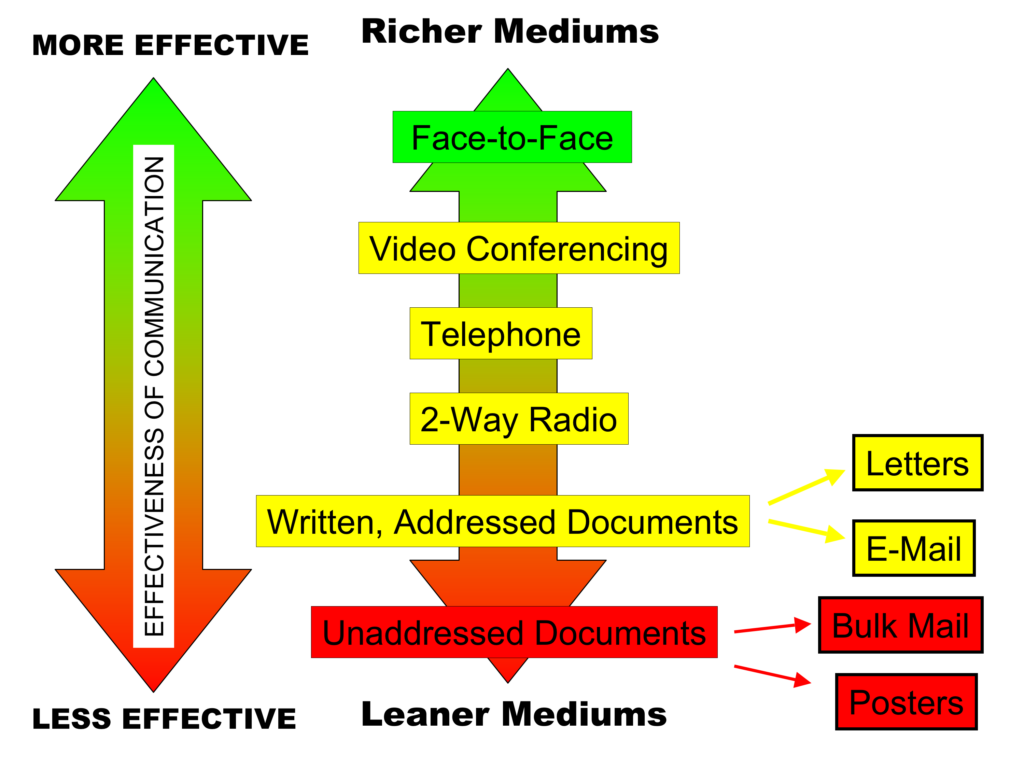There’s no getting around it. We are working remotely, from our homes. Communication is harder. We need to make the best of the situation. You’re not likely to be able to implement everything in this article—because we’re all uniquely constrained by our home situations—but I suggest you try.
Communication is seemingly the main issue when I ask what makes remote collaboration harder than what we’re used to. Communication, however, can mean many things. In this case, it is about a) voice only not conveying as much information, and b) video still not being a substitute for in-person engagements. These concerns go well in hand with research such as media richness theory.

Some also suggest that remote collaboration drains more energy for them. Others miss the whiteboards and information radiators that previously helped improve communication—through transparency, visibility, and objectivity of information and what’s usually inside of our heads.
There may not be any real substitute for face-to-face communication, yet, we have to try.
Note: This article focus on bettering our synchronous remote communication. I’m also a firm believer that we do far too much synchronous communication even when we’re not working from home. I might write about that another day, but for now, I recommend Basecamp’s Guide to Internal Communication.
Suggestions for improving remote communication
- Default to Video On. One of the main reasons that face-to-face communication works so well is how we, as humans, express emotion through our facial expressions. While we communicate, seeing each other helps us relate and infer how what we’re trying to convey is received by others.
- Use floating windows when screen sharing. Remote communication is done a lot through sharing what’s on one’s screen in some way. This can be devastating, as our software often neglects the importance of continued visual connection with each other. The presenter loses contact with the other participants, and the other participants lose connection with the presenter.
- Be creative with digital whiteboards. Most people are probably using digital whiteboards in some capacity by now. Some might even have come to prefer them in some ways, thanks to—for example—their endless canvases. Still, improvements can be made. One such adjustment is to have your tablet, e.g., iPad, ready. Most digital whiteboards support writing on them with your tablet, which is far closer to analogue writing. It reduces friction for adding things to the whiteboard and works well for brainstorming and being creative. Another plus with tablets is that you can use them as a secondary screen unless you already have one, which is another excellent place for broad context sharing while working on something.
- Keep it on the same screen. This is not always going to be the case, and I’ll expand on it with the next tip, but when it comes to improving remote communication, I find it preferable to keep your colleagues, the work, and extra context on one screen. Learn your tools. Discover what works for you regarding how much space you use for the work itself, your colleagues’ videos, and the extra context. The last one is the most difficult, and thus here’s my next suggestion.
- Upgrade your screen estate. Screen estate is king when it comes to working remotely. If you haven’t already, ask your company to send your office screen to your home or buy a new screen for you to use at home. Do not work every day from a ~13″ laptop screen; it’s terrible for you and your colleagues. Two screens are often ideal, or one large screen and your laptop/tablet. Everything I talked about above becomes better with generous screen estate.
- Improve your connection. We have worked from home for close to a year now. Have you improved your wifi connectivity at home? Have you connected your computer physically to your router? If not, it’s time to do so. Again, for all of the above suggestions to work, we do need bandwidth. Most of us have this in Sweden, yet many of us don’t use it correctly.
And here are some software applications to consider
- Zoom. Zoom has had its fair share of recognition this year. Its growth has been remarkable, and so the news about their security problems with people jumping in on random meetings. They fixed their security, to my knowledge, and I have yet to find a better software for video conferences, seminars, and meetings.
- Miro or Mural. The marketplace for digital whiteboards must have exploded this year, and yet what has continued to work for me is Miro and Mural. Mural seems a bit easier for participants to get started with, but Miro is, in my experience, the more continuously improving product.
- mmhmm. I recently discovered this lovely app called mmhmm. Weird name, I know, yet their catchphrase, “It’s your show,” really rings true. “Let yourself shine.” Elevate your content.” “Collaborate naturally.” Their copywriting is on point, and I suggest you visit their website.
- Tuple. My final suggestion is for all of you developer out there struggling with getting pair-programming and mob-programming to be as fun and productive as it was in the office. They offer “seamless control for two,” “crazy-low CPU usage,” “ridiculously crisp audio and video,” and more.
Those are my suggestions for improving your remote communication and collaboration today. What are your tips, advice, and app recommendations? Please share in the comments.